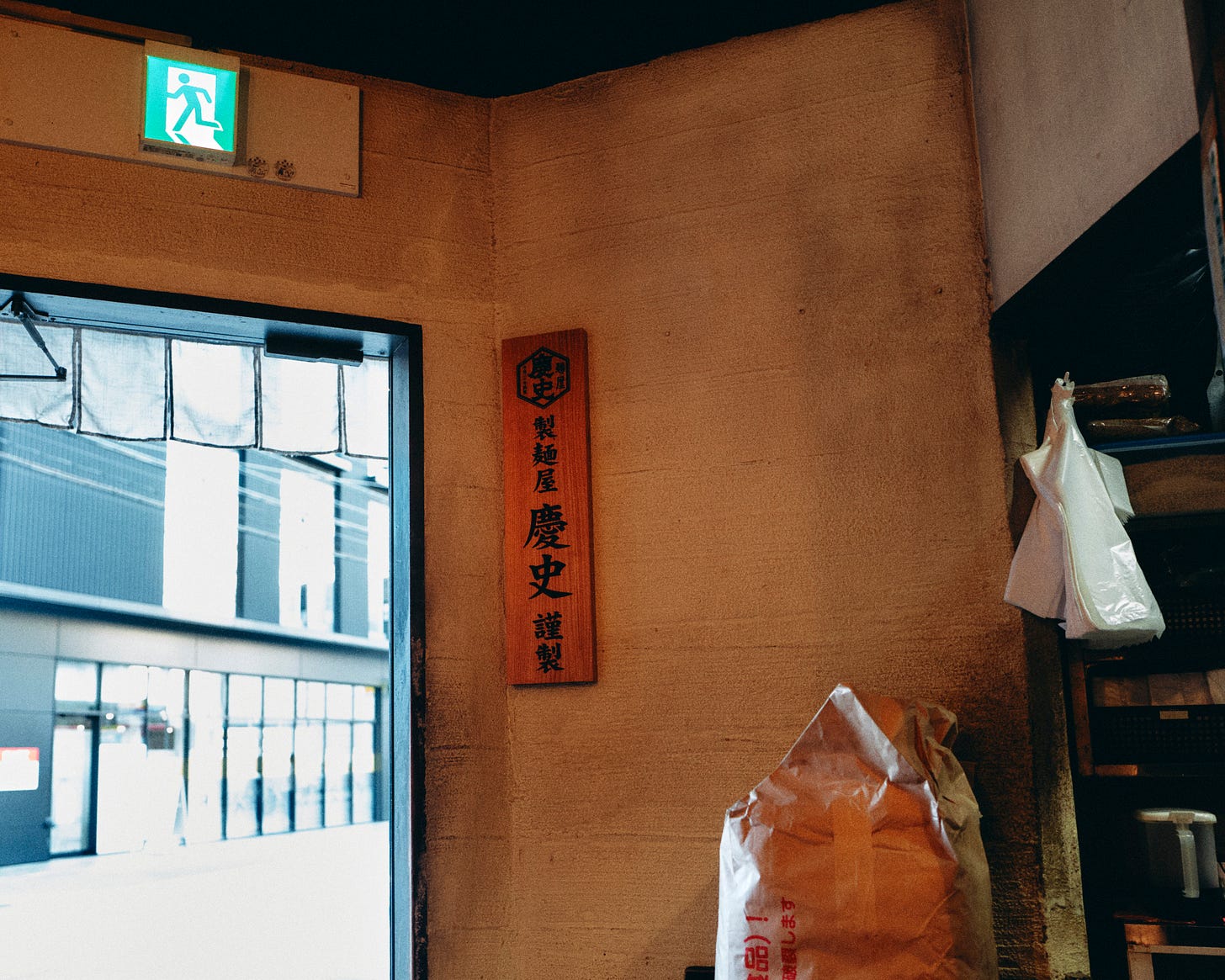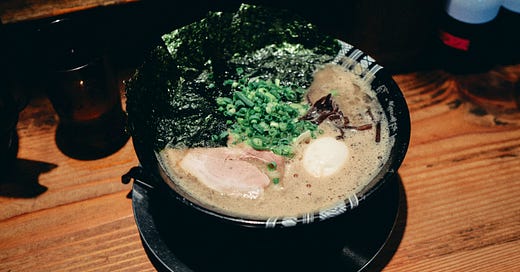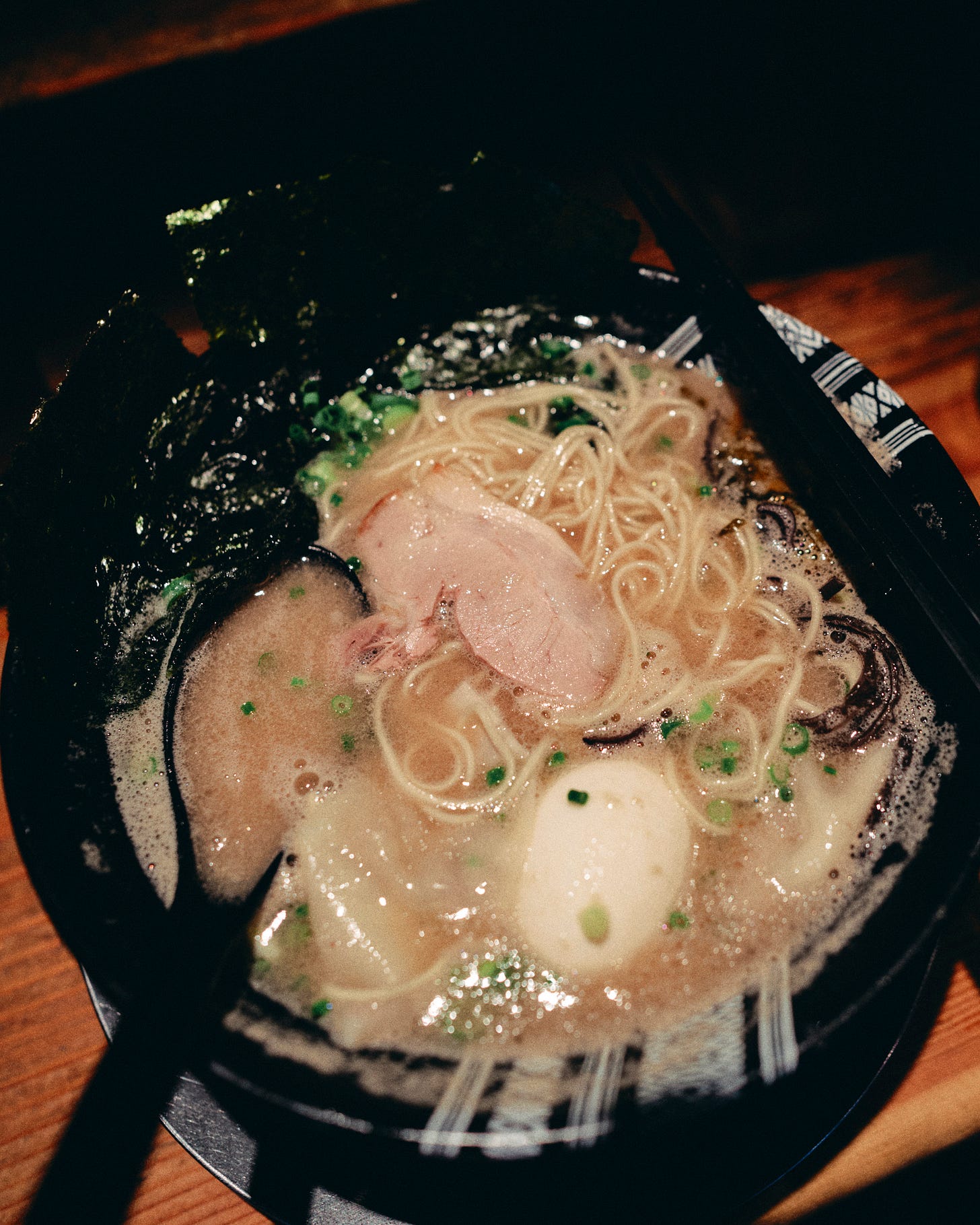Tonkotsu Cappucino.
“Japanese pork ribs or chicken with potatoes?” The cabin crew asked.
“Water, please.” I shook my head.
I skipped the meal from Melbourne to Hong Kong. I could skip Hong Kong to Fukuoka too.
“How about mooncakes?” She held one in the air.
Nah I’m-wait, are those mooncakes from Mei Sum?
Those are going for $25 per piece in Chinatown. Nice touch, Cathay Pacific.
I'll take one, but for later.
I'm saving my appetite.
That's the right thing to do.
The actual right thing to do, once I landed, was to catch the free bus to the domestic airport, then the subway straight to Nishi-ku to reunite with my family.
Chika even offered to pick me up from the airport.
But I declined.
Too much trouble for one person.
It wouldn't make any difference.
The truth is I wanted to take the train, so I could stop by Hakata Station, walk through the east exit, and visit the 2nd highest-ranked ramen shop in Fukuoka, according to Tabelog.
As the gates opened, reality hit.
When I imagined eating ramen, it was on the couch of my post-winter Melbourne home. In my PJs.
In that narrative, I was not dehydrated, fatigued, or fully assaulted by Fukuoka's heat wave.
Fuck this, dude. My inner voice said.
No, I’ve done too much research, invested too much, even committed culinary adultery, to give up now.
Now that I’d survived the plane, I was sure I’d meet my family.
Yet I wasn’t sure if I’d get to visit Hakata Station again.
Hakata Issou (博多一双) was started by the Yamada brothers1 in 2012, having graduated from a local establishment.
I suspect the ‘local establishment’ here is Ikkousha (一幸舎), the ruling franchise of Hakata ramen, the mother to Hakata Gensuke in Australia.

The brothers were 25 and 21 respectively.
Within 10 years, they have expanded to three branches, and to say ‘cult status’ is an insult. They are official blockbusters. Famous for the long queues.
They have even registered the name ‘Tonkotsu Cappucino’, coined by a customer, to describe the thick layer of foamy fat (脂泡) floating on their bowl of tonkotsu ramen.
If you ever wonder how the ramen influencers or bloggers sniff out new ramen places, come closer, let me tell you the secret.
They know, or know someone who knows Japanese.
If you type ‘best ramen Fukuoka’ in English search engines, then you’ll find English result, ramen blogs, Youtube reviewers, Reddit, maybe some nerd who brings a refractometer to measure the BRIX level of ramen broth. A directory, best 10, advertising as best. In an English context.
I’ve mentioned before that locals use Tabelog - the Japanese Urbanspoon (RIP).
And every year, Tabelog releases a Best 100 list of food.
I go to the sidebar, choose ‘ramen’, and pick the prefecture I’m in, and voila, I get to see who’s on the top 100 in Fukuoka.
And if I click on one of the shops in Fukuoka, and sort by ranking2, then I get the scores.

And kids, this is how you know Hakata Issou is ranked second in Fukuoka.
The first? Well, I already wrote about Genkki Ippai last year.
Your teacher was right though, knowing more than one language will give you a spoonful of edge in life.
Once I got out of Hakata Station, located the east exit, found a locker to stuff my luggage, it was almost 5pm. On my walk there, I could only pray no one in their right mind would queue up for ramen on a Monday evening.
And luck was by my side. It was semi-empty. So different from all the YouTube videos and press photos I’ve seen.
I swear, if it wasn’t for momentum, I’d turn away.
I did not have time to go through the ticket machine or take a photo for you, I just hit the ‘signature special’ button (特製ラーメン).
Signature ramen with egg, nori, black fungus, charsiu, and wonton.
If you’re in the restaurant business, then you must have heard of the phrase Standard Operating Procedure (SOP).
When you sell or buy a restaurant, the SOP is what you’re after.
In short, a ‘system’ - an algorithm or process the new owner can digest, follow, and replicate almost immediately without losing quality, or customers.
See: Ding Tai Fung, Tim Ho Wan, Ippudo, or any chain restaurants you see that went from one continent to the other.
See also: central kitchen, uniforms, cookie-cutting fit-outs, working-holiday visas.
As I tasted my first sip of the broth, I immediately thought of Hakata Gensuke.
But thicker, grittier, punchier. As if they boiled the bones and blended it to oblivion.
It’s porky, but as you are expecting the taint to hit, it kinda went away. Like hide and seek. You try the next mouthful, it’s there and gone again.
My mind wandered to Kurume last year, but not as stinky.
It went to Genki Ippai, but not as smooth, or milky.
They took the SOP from Ikkousha, and made it local, and transparent.
On their website they introduced collaborators - noodle supplier, pork supplier, spring onion farmer3, soy sauce supplier, bowl maker, apron designer, signage calligrapher … almost a dare.
Try and copy us, if you can.
What I’d like to know, is their nori and egg supplier. Super flavourful.
Ask a Singaporean this question: ‘It’s only chicken rice, how can one be so much better than the other?’
Take a step back, and see them lose it.
It’s the texture of the rice. It’s how the skin separates from the chicken. It’s the gel between the skin. It’s the fragrance of the rice. It’s the amount of ginger in the ginger oil. It’s the amount of sourness in the chili sauce. It’s how fluffy the rice should be. It’s how sticky the rice should be. it’s how oily the rice should be. It’s how light the soup should be. It’s how sticky the black sauce should be. It’s how tender the breast should be ….
When a dish is reduced to four to five elements, you can’t help but be picky.
Which is also why ‘modern’ ramen is all about random toppings and colours. Or miscellaneous umami bombs, fried crispy strands, with golden foil, sea urchin, your mother’s wagyu, or duck breast. To distract you.
When a dish is reduced to four to five elements, there is also nowhere to hide.
To sum up my bowl of Hakata ramen at Issou:
It’s as if someone pointed to a bowl of tonkotsu ramen, or even a ramen shop, and yelled ‘enhance everything’, and a pair of brothers did it.
Like a documentary, I could feel my sugar levels, my life force, my six meridians slowly restoring and balancing themselves.
After spicy mustard leaves, sesame seeds and garlic, hunger, desperation, and fear are the best seasoning.
Downside? The price.
1350 yen for the special which includes the egg, some nori, a poor attempt they claim to be ‘wonton’, the loneliest charsiu i’ve seen … it’s officially the most expensive bowl of ramen in Fukuoka. It’s 15 Australian dollars, but adjusted to our minimum wage, it’s almost $40.
Downside? Also SOP.
The reason I’ve been reluctant to try Hakata Issou compared to say Hanamokoshi, or Genki Ippai all these years, is that I could smell the strong SOP as much as as the pork bone broth a mile away. The other two were manned by their owners. Hanamokoshi even made his noodles onsite. There’s a sense of Japanese artisanal, or ‘sacrifice’ as we call it.
All the staff in Issou were so young, like straight out of high school. Almost robots.
They were still making mistakes in the kitchen, making loud crashes, and made it worse by apologising louder than the crash.
The young master was running out of spoons. He went from ‘spoons please’ to ‘spoons goddamnit’ in no time.
The whole point of offering seats at the counter, is for the customers to admire the process, not to absorb the stress of the working conditions.
Not to realise I’m here to flip tables.
I ran back to Hakata Station, with severe pork and garlic breath - I had to catch the 5.45pm train. It’s peak hour rush, but if I missed that I’ll be hit with the mother of peak hour rush. My luggage, they were still in the locker4.
As I stood in the cramped train compartment, with that familiar lingering chokehold of MSG on my throat, I had no surprise, no wonder that people queue up for hours just for Hakata Issou.
It’s the perfect orchestrated bowl of Hakata Tonkotsu ramen.
A signature’s signature.
The Five Guys to McDonald’s.
Those of you who do not like tonkotsu to start with can skip it. It won’t change your mind.
Those of you who do, know that tourists queue at Ichiran and Ippudo; the locals queue at Issou5.
And it’s only a matter of time before Issou becomes the other two I’s.
Before you wonder how I’m still breathing by openly prioritising ramen before my family, don’t worry. Remember how I mentioned learning a second language is essential to sniff out the true ramen joints in Japan? This post is sponsored by Japanese Australia, an online Japanese language school powered by a physical school in Melbourne. So you can be sure that your teachers are qualified native instructors from Japan; not some bots or backpackers. Start a thirty Kangaroo dollar trial, or if you have some experience learning Japanese, the level check is free. My commission? I get to live to see another day.
I assume the meaning behind the kanji ‘one pair’ was referring to the two brothers. It could be chopsticks, or balls.
You can only sort ranking on the desktop website. The mobile site will give your phone advertising cancer.
Itoshima! My wife’s turf.
Speaking of price, the locker fee for my luggage was 1000 yen. The real sacrifice for me to write this post for you.
The only ‘foreigner’ I saw was one of the staff, and probably myself.







